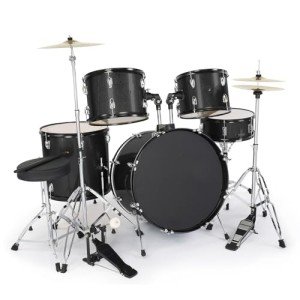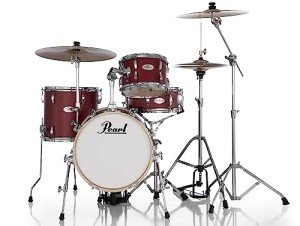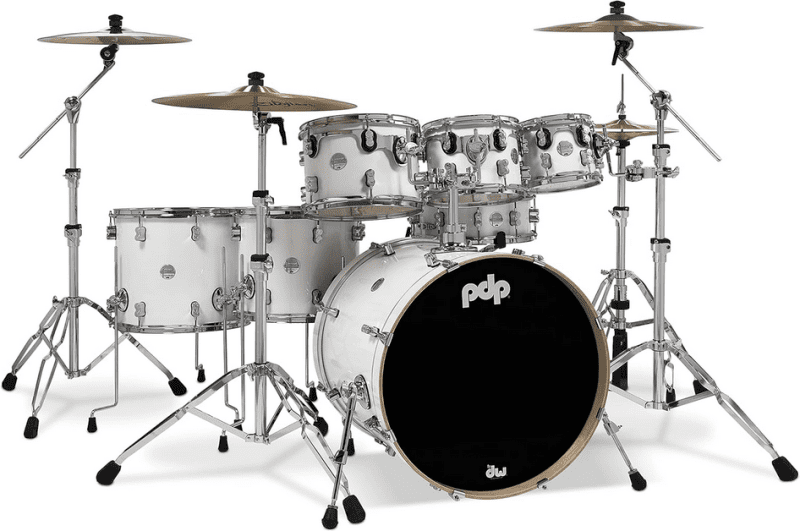Master the Art of Double Bass Drumming with Ease!
If you're a drummer looking to take your skills to the next level, double bass drumming is an essential technique to master. The ability to play two bass drums or use a double pedal can add depth and excitement to your drumming style, whether you're playing metal, rock, or any other genre.
In this article, I'll take you through the world of double bass drumming, providing tips, techniques, and exercises to enhance your abilities. Whether a beginner or an experienced drummer, you'll find valuable insights to improve your bass drumming technique, speed, coordination, and control.
Key Takeaways:
- Double bass drumming can add depth and excitement to your drumming style.
- Whether you're a beginner or an experienced drummer, there are tips, techniques, and exercises to enhance your abilities.
- Improving your bass drumming technique, speed, coordination, and control is crucial for mastering double bass drumming.
- Mastering double bass drumming opens new possibilities for creating unique and dynamic drum patterns.
- Advanced techniques and exercises can push your skills to the next level and help you become a powerhouse on the drum kit.
Understanding Double Bass Drumming Techniques
When it comes to mastering double bass drumming, understanding the right techniques is crucial. Without proper technique, you won't be able to execute the complex patterns that define this drumming style. In this section, I'll take you through the essential drumming techniques that will help you take your double bass drumming skills to the next level.
First and foremost, speed and control are key aspects of double bass drumming. To develop your speed, focus on playing with your toes and the ball of your feet, rather than your entire foot. This technique will help you play faster without getting tired as quickly.
Drumming tutorials are an excellent resource for learning proper double bass drumming techniques. YouTube offers a wide range of tutorials from professional drummers, breaking down the different aspects of double bass drumming from basic patterns to advanced techniques. These tutorials can help you develop your skills and build your confidence.
The double kick pedal is the foundation of double bass drumming. One technique to master is heel-toe, which involves hitting the pedal with your heel and then using the ball of your foot to hit it again. This technique allows you to play faster and more accurately.
Finally, practice with a metronome to improve your timing and control. Start slow and gradually increase the tempo as you become comfortable with the patterns.
Incorporating these techniques into your practice routine will help you develop the speed and control necessary for double bass drumming. Stay committed to your practice; before you know it, you'll be executing complex patterns easily.
Building Bass Drum Speed and Coordination
One of the most important aspects of double bass drumming is building speed and coordination in your bass drum technique. It may seem daunting at first, but with the right exercises and practice, you can develop the skills needed to take your drumming to the next level.
A key element in building speed and coordination is mastering the double pedal. This pedal allows you to play two bass drums simultaneously with one foot. When incorporating the double pedal into your drumming technique, it's important to ensure that both feet hit the bass drums simultaneously.
One exercise to improve your double pedal technique is playing 16th notes at a slow tempo, gradually increasing speed over time. Another helpful exercise is to practice playing four strokes with your right foot, followed by four strokes with your left foot, and repeating this pattern. This exercise helps to build coordination between your feet and improve your overall bass drumming technique.
In addition to utilizing the double pedal, it's important to focus on foot technique. Please pay attention to the angle of your foot as it strikes the bass drum, and use your ankle and knee to create a fluid motion. Exercises such as heel-toe and slide techniques can also help improve your foot technique and speed.
Incorporating drumming exercises into your practice routine is crucial for building bass drum speed and coordination. Practice playing various bass drum patterns at different tempos, gradually increasing your speed over time. You can also try playing along to your favorite songs, focusing on matching the bass drumming patterns and increasing your speed and control as you go.
By building bass drum speed and coordination through the double pedal, perfecting your foot technique, and incorporating drumming exercises into your practice routine, you'll be well on your way to mastering double bass drumming techniques.
Mastering Double Bass Drum Patterns
Creating unique and dynamic drum patterns is a fundamental aspect of double bass drumming, and mastering various patterns can take your drumming to new heights. This section will delve into different bass drumming patterns and explore exercises to help you master them.
One of the key tools in double bass drumming is the double bass drum pedal. To make the most out of this tool, developing a strong sense of coordination between both feet is essential.
One useful exercise is practicing basic eighth-note patterns alternating between both feet, such as RLRLRLRL or LRLRLRLR, gradually building up speed and control. Once you've mastered these basic patterns, you can move on to more complex patterns.

A popular pattern among drummers is the "Gallop," which involves playing three notes with one foot and the fourth note with the other foot, creating a galloping rhythm. Another popular pattern is the "Blast beat," which features a sixteenth-note pattern between both feet with the snare drum played on the third note.
It's important to take your time when practicing these patterns and incorporate them into your playing gradually. As you build up your muscle memory, you'll find that you can seamlessly switch between patterns and incorporate them into your performances.
Double Bass Drum Pedal Techniques
The double bass drum pedal is an essential tool in double bass drumming, and mastering it can help you create intricate and complex patterns. Many drummers use the "Heel-Up" technique, which involves using your heel to strike the pedal with force, creating a loud and powerful sound. Another technique is the "Heel-Down" technique, which involves keeping your heel on the pedal and using your toes to create a softer, more subtle sound.
Experiment with these techniques to find what works best for you and the sound you want to create. Incorporate them into your practice routine and gradually build up your speed and control.
Kick Drum Exercises
Finally, practicing kick drum exercises can also help you master double bass drumming patterns. One popular exercise is the "Single-Stroke Roll," which involves playing a constant stream of alternating strokes between both feet. You can also practice "Double-Strokes," which involves playing two strokes with one foot followed by two strokes with the other foot.
As with all exercises, start slow and gradually build up your speed and control. The key to mastering kick drum exercises is to focus on precision and accuracy, not just speed.
By incorporating these techniques and exercises into your practice routine, you'll be well on your way to mastering double bass drumming patterns and elevating your drumming skills to new heights.
Advanced Techniques for Double Bass Drumming
Are you ready to take your double bass drumming skills to the next level? It's time to explore advanced techniques that impress everyone around you. This section will share some of my favorite advanced double bass drumming techniques and tips.
Double Bass Drumming Techniques for the Pro Drummers
To take your double bass drumming to the next level, you need to master some advanced techniques. One of the techniques that pro drummers use is the "Heel-Toe" technique. This technique involves using both your heel and toe to hit the bass drum pedals in quick succession, allowing you to play at a faster speed.
Another technique that adds complexity to your drumming is the "Blast Beat," which is popular in metal music. This technique involves playing a series of quick notes with the double bass drum pedal, allowing you to create a fast and aggressive drumming pattern.
Advanced Bass Drumming Exercises
Practice makes perfect, and that's especially true when it comes to advanced double bass drumming. One exercise you can try is playing a series of sixteenth notes with one foot while playing quarter notes with the other foot. This will help you develop precision and coordination between both feet.
You can also try playing various patterns that combine the bass and snare drum. This will help you develop new rhythms and improve your overall drumming abilities.
Double Bass Pedal Techniques
The double bass pedal is an essential tool for double bass drumming. Mastering the double bass pedal takes time, but you can create incredible drumming patterns once you have it down. One way to practice using the double bass pedal is to play quarter notes with one foot and eighth notes with the other foot.
Another technique you can try is playing with a "swivel technique." This technique involves moving your foot in a circular motion to increase speed and power.
Mastering advanced double bass drumming techniques requires dedication and practice. By incorporating new techniques and exercises into your practice routine, you'll see significant improvements in your drumming abilities. Take your time, start slow, and focus on precision and control. Keep pushing yourself, and soon you'll be an advanced double bass drumming expert!
Improving Bass Drum Control and Stamina
As I mentioned earlier, developing control and stamina is essential for any drummer, especially when it comes to double bass drumming. Here are some tips and exercises to help you take your bass drumming to the next level:
Bass Drum Control
One of the keys to mastering double bass drumming is developing control over your bass drum. Here are some tips:
- Start slow and gradually increase your speed.
- Practice playing single strokes with both feet evenly and consistently.
- Focus on playing with your ankle, not your entire leg.
- Use a metronome to improve your timing and accuracy.
By focusing on these tips and practicing regularly, you'll gain better control over your bass drum and improve your overall double bass drumming skills.
Double Bass Drumming Patterns and Tips
Along with developing control, it's important to learn and master different double bass drumming patterns. Here are some tips:
- Practice with different time signatures and tempos to challenge yourself.
- Experiment with different patterns and create your own unique beats.
- Watch drumming tutorials and learn from experienced drummers to expand your knowledge and skills.
- Use a click track or drum machine to help you stay in time.
By incorporating these tips and techniques into your practice routine, you'll be able to expand your repertoire of double bass drumming patterns and create your own unique beats.
Drumming with Two Bass Drums and Advanced Techniques
If you're looking to take your double bass drumming to the next level, consider drumming with two bass drums and exploring advanced techniques. Here are some tips:
- Make sure your bass drums are tuned and matched in terms of size and tension.
- Start slow and gradually increase your speed.
- Practice playing different patterns and combinations with both feet simultaneously.
- Use a double bass pedal to create more intricate patterns.
By incorporating these tips and techniques, you'll be able to explore advanced techniques for double bass drumming and take your skills to the next level.
Bass Drum Speed Exercises
Finally, if you're looking to improve your bass drumming speed, here are some exercises to try:
- Practice playing double strokes with both feet, gradually increasing your speed.
- Use a metronome to improve your timing and accuracy.
- Practice playing paradiddles and other rudiments with your feet.
- Warm up your feet with exercises such as heel-toe and slide techniques.
By incorporating these exercises into your practice routine, you'll be able to improve your bass drumming speed and stamina, allowing you to play longer and more complex beats.
Conclusion
Well, that's it, folks! I hope you found this article helpful in mastering the art of double bass drumming. Remember, becoming a proficient drummer doesn't happen overnight, but you can achieve your goals with dedication and practice.
Recap
Let's take a moment to recap what we've covered in this article. We started with the basics, exploring double bass drumming techniques and how to develop speed and control. We then built bass drum speed and coordination through various exercises and techniques.
Next, we explored how to master double bass drum patterns and advanced techniques to take your drumming skills to the next level. We also discussed improving bass drum control and stamina, essential for any drummer.
Final Thoughts
Double bass drumming is an exciting and challenging drumming style that takes time and effort to master. Remember that every drummer is unique; what works for one person might not work for you. It's essential to experiment and find what works best for you.
Finally, don't forget to enjoy the journey! Drumming should be fun and fulfilling, and with the skills you've learned in this article, you'll be able to play with confidence and excitement. Keep practicing, and you'll soon be wowing audiences with your double bass drumming skills.
FAQ
Q: What is double bass drumming?
A: Double bass drumming is a drumming technique that involves using two bass drums or a double kick pedal to create a rapid succession of bass drum hits. It is commonly used in genres such as metal and rock to create powerful and intricate drum patterns.
Q: Can I learn double bass drumming as a beginner?
A: Absolutely! While double bass drumming may seem intimidating, anyone can learn it with practice and dedication. Start by focusing on basic techniques and gradually build up your speed and coordination. With time and patience, you can master double bass drumming.
Q: Are there any specific exercises to improve bass drumming speed?
A: Yes, various exercises can help improve your bass drumming speed. Some popular exercises include heel-toe technique exercises, endurance exercises, and practicing drumming exercises with a metronome. Consistent practice and gradually increasing your speed will improve your bass drumming speed.
Q: How can I improve coordination between both feet in double bass drumming?
A: Developing coordination between both feet is crucial in double bass drumming. One effective way to improve coordination is to start with simple bass drum patterns and gradually add complexity. Practice slowly at first, focusing on synchronizing your foot movements, and gradually increase the speed as you become more comfortable.
Q: What are some common double bass drumming patterns?
A: There are various double bass drumming patterns to explore. Some common patterns include the alternating pattern (right foot, left foot), the triplet pattern, and the galloping pattern. Experiment with different patterns and incorporate them into your drumming style to add variety and excitement.
Q: Are there advanced techniques for double bass drumming?
A: Once you have a solid foundation in double bass drumming, you can explore advanced techniques. Some advanced techniques include blast beats, double strokes, and complex footwork patterns. These techniques require practice and precision to master but can greatly enhance your double bass drumming skills.
Q: How can I improve bass drum control and stamina?
A: Improving bass drum control and stamina requires focused practice and exercises. Start by practicing slow and controlled bass drum strokes, gradually increasing the speed. Incorporate endurance exercises like playing steady bass drumming patterns for an extended period of time. Consistency and gradual progression are key to improving bass drum control and stamina.








